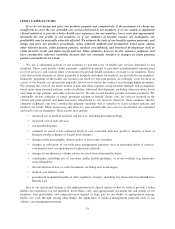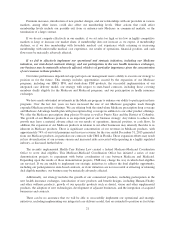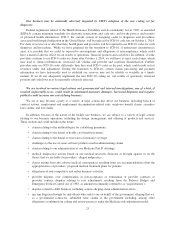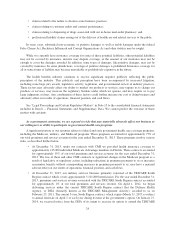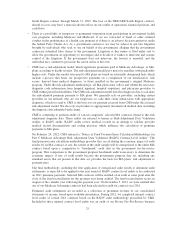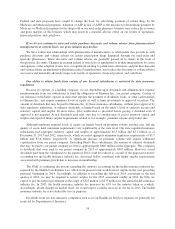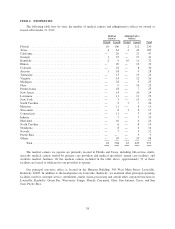Humana 2013 Annual Report Download - page 38
Download and view the complete annual report
Please find page 38 of the 2013 Humana annual report below. You can navigate through the pages in the report by either clicking on the pages listed below, or by using the keyword search tool below to find specific information within the annual report.for new market entrants), establishes federally-facilitated or state-based exchanges for individuals and small
employers (with up to 100 employees) coupled with programs designed to spread risk among insurers, and
expands eligibility for Medicaid programs. In addition, the Health Care Reform Law has increased and will
continue to increase federal oversight of health plan premium rates and could adversely affect our ability to
appropriately adjust health plan premiums on a timely basis. Financing for these reforms will come, in part, from
material additional fees and taxes on us and other health plans and individuals beginning in 2014, as well as
reductions in certain levels of payments to us and other health plans under Medicare. Implementation dates of the
provisions of the Health Care Reform Law began in September 2010 and continue through 2018.
Implementing regulations and related interpretive guidance continue to be issued on certain provisions of
the Health Care Reform Law. Given the breadth of possible changes and the uncertainties of interpretation,
implementation, and timing of these changes, which we expect to occur over the next several years, the Health
Care Reform Law will change the way we do business, potentially impacting our pricing, benefit design, product
mix, geographic mix, and distribution channels. The response of other companies to Health Care Reform Law
and adjustments to their offerings, if any, could cause meaningful disruption in the local health care markets. It is
reasonably possible that the Health Care Reform Law and related regulations, as well as future legislative
changes, including legislative restrictions on our ability to manage our provider network, in the aggregate may
have a material adverse effect on our results of operations (including restricting revenue, enrollment and
premium growth in certain products and market segments, restricting our ability to expand into new markets,
increasing our medical and operating costs, lowering our Medicare payment rates and increasing our expenses
associated with the non-deductible health insurance industry fee and other assessments); our financial position
(including our ability to maintain the value of our goodwill); and our cash flows (including the receipt of
amounts due under the commercial risk adjustment, risk corridor, and reinsurance provisions of the Health Care
Reform Law in 2015 related to claims paid in 2014). If we fail to effectively implement our operational and
strategic initiatives with respect to the implementation of the Health Care Reform Law, our business may be
materially adversely affected. In addition, if we are unable to adjust our business model to address the non-
deductible health insurance industry fee and other assessments, including a three-year commercial reinsurance
fee, such as through the reduction of our operating costs or adjustments to premium pricing or benefit design,
there can be no assurance that the non-deductible health insurance industry fee and other assessments would not
have a material adverse effect on our results of operations, financial position, and cash flows.
Our participation in, and the operational functionality of, the new federal and state health insurance
exchanges, which have experienced certain technical difficulties in their early implementation, and which
entail uncertainties associated with mix and volume of business, could adversely affect our results of
operations, financial position, and cash flows.
The Health Care Reform Law requires the establishment of health insurance exchanges for individuals and
small employers to purchase health insurance that became effective January 1, 2014. Open enrollment on the
exchanges began on October 1, 2013 and continues until March 31, 2014. Among other things, the exchanges
have websites where individuals and small employers can shop for and purchase health insurance. Certain health
insurance exchange websites have experienced technical difficulties in their early implementation. The
accessibility and functionality of the exchange websites and the accuracy of the information we are provided
from them by the federal and state governments are central to both the enrollment process and our ability to
understand and service this new member population.
The Health Care Reform Law requires insurers participating on the health insurance exchanges to offer a
minimum level of benefits and includes guidelines on setting premium rates and coverage limitations. We may
be adversely selected by individuals who have a higher acuity level than the anticipated pool of participants in
this market. In addition, the risk corridor, reinsurance, and risk adjustment provisions of the Health Care Reform
Law, established to apportion risk for insurers, may not be effective in appropriately mitigating the financial risks
related to our products. When we established premiums, we had limited information about the individuals
accessing these newly established exchanges. In addition, regulatory changes to the implementation of the Health
28



